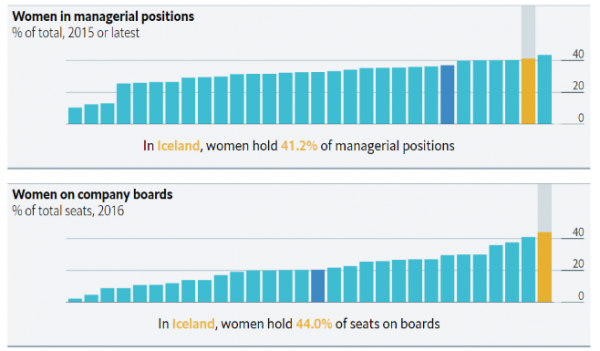Iceland is frequently held up as an example of gender equality. In 1980 Iceland elected the world's first democratically elected female head of state, Vigdís Finnbogadóttir, a single mother. In 1983 Icelandic women, tired of being ignored by the traditional parties, founded their own political party: The Women's List. Today women hold 30, 48% of the 63 seats in Parliament.
Iceland still has a long way to go before full gender equality has been reached. For example, women still earn 13.6% less than men. Nonetheless, Iceland seems to be closer to the goal of equality than other OECD countries. At least when it comes to working women: According to The Economist's Glass Ceiling Index, a metric which tracks women's chances of equal treatment in the workplace.
The index is a weighed average of the performance on ten indicators, including higher education, workforce participation, pay, child-care costs, maternity and paternity rights, business-school applications and representation in senior jobs. Iceland tops the list on many of these scores and doing significantly better than the OECD avarage on all measurements, except the length of paid maternity leave. Icelandic women get 16.6 weeks of paid maternity leave, while the OECD average is 32.2 weeks.
Iceland compared to US, UK and OECD average
Iceland does better than both the US and UK on every single measure – except the share of managerial positions held by women. The US leads the OECD on this measure, with 43.4% of managerial positions, followed closely by Iceland. In Iceland women hold 41.2% of managerial positions and 44% of seats on boards, compared to the OECD average of 31.7% of managerial positions and 20.5% of seats on boards. In the US women hold just 20.3% of seats on boards, in the UK women hold 35.4% of managerial positions and 25.5% of seats on boards.

In Iceland the labour participation rate for women is 4.8% lower than men's, compared to the OECD average of 16.7 points lower, 11.5 points lower in the US and 10.3 lower in the UK.

In Iceland women earn 13.6% less than men, compared to the OECD average of 14.6% less, 18.9% less in the US 18.9% and 16.9% less in the UK.

Icelandic women hold 47.6% of seats in parliament compared to the OECD average of 28.2%, 19.2% for the US and 29.6% in the UK.

In Iceland net child-care costs are just 6.5% of the average wage compared to the OECD average of 18.2%, 35.1% in the US and 45.7% in the UK.

Icelandic women get the equivalent of 16.6 weeks of paid maternity leave, compared to the OECD average of 32.2 weeks, 12.2 in the UK and zero in the US.

Iceland is frequently held up as an example of gender equality. In 1980 Iceland elected the world's first democratically elected female head of state, Vigdís Finnbogadóttir, a single mother. In 1983 Icelandic women, tired of being ignored by the traditional parties, founded their own political party: The Women's List. Today women hold 30, 48% of the 63 seats in Parliament.
Iceland still has a long way to go before full gender equality has been reached. For example, women still earn 13.6% less than men. Nonetheless, Iceland seems to be closer to the goal of equality than other OECD countries. At least when it comes to working women: According to The Economist's Glass Ceiling Index, a metric which tracks women's chances of equal treatment in the workplace.
The index is a weighed average of the performance on ten indicators, including higher education, workforce participation, pay, child-care costs, maternity and paternity rights, business-school applications and representation in senior jobs. Iceland tops the list on many of these scores and doing significantly better than the OECD avarage on all measurements, except the length of paid maternity leave. Icelandic women get 16.6 weeks of paid maternity leave, while the OECD average is 32.2 weeks.
Iceland compared to US, UK and OECD average
Iceland does better than both the US and UK on every single measure – except the share of managerial positions held by women. The US leads the OECD on this measure, with 43.4% of managerial positions, followed closely by Iceland. In Iceland women hold 41.2% of managerial positions and 44% of seats on boards, compared to the OECD average of 31.7% of managerial positions and 20.5% of seats on boards. In the US women hold just 20.3% of seats on boards, in the UK women hold 35.4% of managerial positions and 25.5% of seats on boards.

In Iceland the labour participation rate for women is 4.8% lower than men's, compared to the OECD average of 16.7 points lower, 11.5 points lower in the US and 10.3 lower in the UK.

In Iceland women earn 13.6% less than men, compared to the OECD average of 14.6% less, 18.9% less in the US 18.9% and 16.9% less in the UK.

Icelandic women hold 47.6% of seats in parliament compared to the OECD average of 28.2%, 19.2% for the US and 29.6% in the UK.

In Iceland net child-care costs are just 6.5% of the average wage compared to the OECD average of 18.2%, 35.1% in the US and 45.7% in the UK.

Icelandic women get the equivalent of 16.6 weeks of paid maternity leave, compared to the OECD average of 32.2 weeks, 12.2 in the UK and zero in the US.








